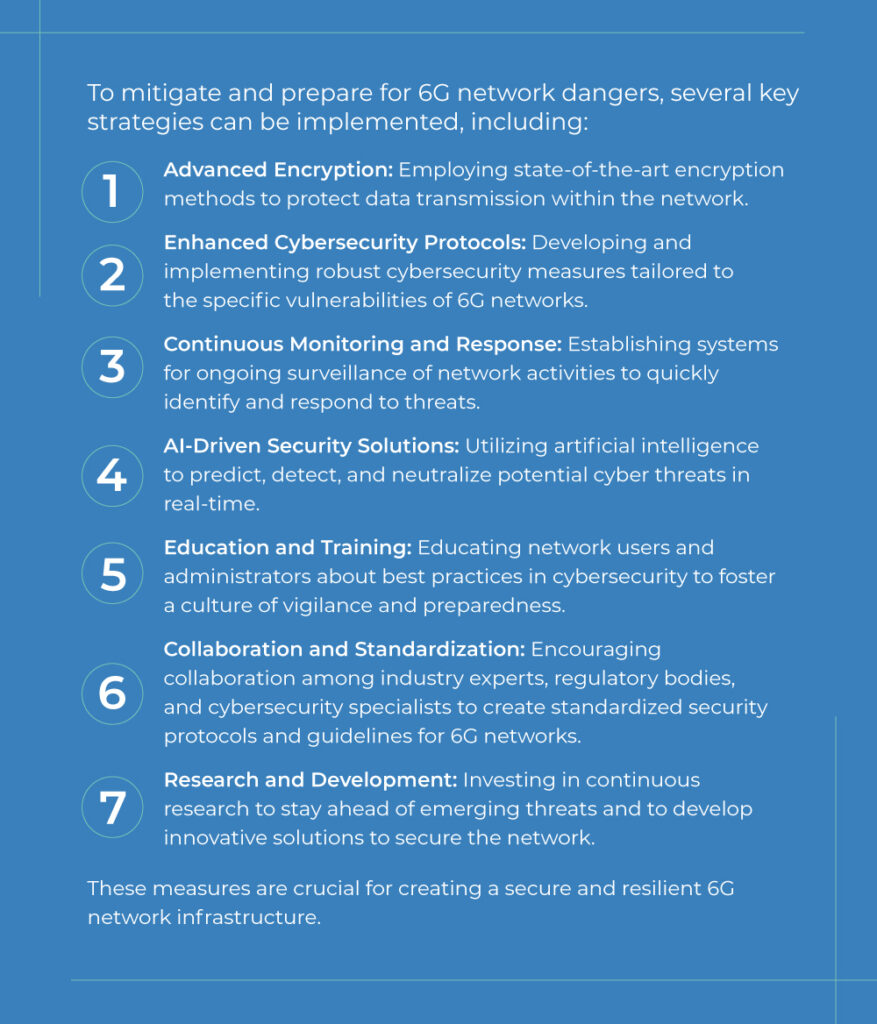As we look to step into the era of 6G technology, it’s crucial to address the inherent security and privacy concerns that come with such advanced connectivity. The leap to 6G introduces complexities and vulnerabilities that could be exploited by cyber threats, raising significant concerns – but what are those concerns that we need to be wary of?
In this article, we’ll discuss what 6G network dangers are and how to mitigate them with the launch of this new, game-changing technology.
What are 6G network dangers?
When people cite 6G network dangers, they’re primarily focusing on 6G’s enhanced cybersecurity threats that are caused by greater speeds and connectivity. With faster speeds and greater digital connectedness, 6G also means greater potential for cyber-attacks and data breaches.
The integration of technologies like artificial intelligence (AI) and Internet of Things (IoT) in 6G networks could introduce new vulnerabilities. Privacy concerns are heightened due to the network’s ability to handle large volumes of data, raising the risk of surveillance and unauthorized data access. Mitigating these risks requires advanced security protocols, encryption, and consistent monitoring to safeguard against evolving cyber threats and ensure user privacy.
Head on over to our guide if you want to learn more about about 6G and AI
What are the dangers of a 6G network?
As we advance towards the 6G era, it’s imperative to understand the potential dangers that accompany this technological leap. 6G promises to transform our digital world with unprecedented speeds and connectivity, but it also introduces new risks that must be carefully navigated. From vulnerabilities in AI and machine learning to challenges in ensuring data privacy and security, let’s take a closer look at these risks and their implications on our daily digital lives.
1. AI and machine learning
With 6G’s reliance on AI and machine learning, the complexity of networks increases exponentially. Leveraging artificial intelligence (AI) and big data technologies, 6G networks will enable a new generation of intelligent applications and services, catering to diverse communication scenarios and requirements. This complexity, while beneficial, can make systems more susceptible to sophisticated cyber-attacks, such as AI-driven threats and deep fake technologies. The concern is not just limited to external attacks; internal errors in AI algorithms can lead to systemic failures, disrupting network operations.
2. Data privacy and security
The increased data capacity of 6G networks, while enabling faster communications, also magnifies the risk of large-scale data breaches. Ensuring the privacy and security of this data will require advanced encryption techniques, more robust security protocols, and possibly new regulatory frameworks to protect users against unauthorized data access and leaks.
Learn more about 6G Network Security in our guide
3. Surveillance and privacy intrusion
6G’s ability to process and analyze data at high speeds opens the door for more sophisticated surveillance techniques. This could potentially lead to unauthorized monitoring, raising serious privacy concerns. Safeguarding against such intrusions will be essential to protect individual rights and maintain trust in 6G technology.
4. Autonomous technology
As 6G enhances the capabilities of autonomous systems, such as self-driving cars and drones, it also raises concerns about the security of these systems. The risk of hacking or malfunctioning in these autonomous technologies could have serious safety implications, necessitating stringent security measures and reliable fail-safes.
5. IoT security challenges
The expansion of IoT devices connected through 6G networks increases vulnerability to cyber threats. Each connected device can potentially serve as an entry point for cyber-attacks, requiring comprehensive security strategies that encompass the entire IoT ecosystem to prevent exploits and secure the network.
6. Spectrum Expansion
6G networks will encompass a wide spectrum including millimeter-wave, sub-6 GHz, terahertz, and optical communications, promising unparalleled network traffic capacity and data speed. While the expansion of spectrum in 6G networks offers increased benefits, it also opens up new avenues for interference and spectrum misuse. Without robust regulatory measures and security protocols, spectrum resources could be exploited for malicious purposes, disrupting communication networks.
7. ERLLC Service Challenges
Achieving ultra-low latency in Enhanced Ultra-Reliable and Low Latency Communication (ERLLC) services requires stringent security protocols to safeguard service and resource availability amidst the proliferation of interconnected devices in the Internet of Everything (IoE) era. Without adequate security measures, the high mobility and interconnected nature of devices in the IoE could be exploited by attackers to compromise network integrity and disrupt critical services.
7 Tips for Preparing for Future 6G Network Dangers
To counter these threats, it’s vital to develop comprehensive security strategies. This includes implementing robust encryption methods, continuous monitoring for vulnerabilities, and developing a proactive cybersecurity culture. Collaboration among industry stakeholders, regulatory bodies, and cybersecurity experts is essential to develop standards and practices that ensure the safe deployment of 6G technology.

To mitigate and prepare for 6G network dangers, several key strategies can be implemented, including:
1. Advanced encryption
In the ever-evolving landscape of cybersecurity threats, employing state-of-the-art encryption methods is paramount to safeguarding data transmission within the network. With quantum computing on the horizon, traditional encryption algorithms may become vulnerable to brute force attacks. Hence, 6G networks must adopt advanced encryption techniques such as quantum-resistant cryptography to ensure data confidentiality and integrity in the face of evolving cyber threats.
6G networks introduce a myriad of new technologies and services, each with its own set of vulnerabilities. To address these challenges, it is imperative to develop and implement robust cybersecurity protocols tailored to the specific requirements and vulnerabilities of 6G networks. This entails conducting thorough risk assessments, identifying potential attack vectors, and designing proactive security measures to mitigate risks effectively.
2. Continuous monitoring and response
In the dynamic landscape of cyber threats, proactive surveillance and rapid response mechanisms are indispensable. Establishing continuous monitoring systems allows network operators to detect anomalous activities and potential security breaches in real-time. By leveraging advanced analytics and threat intelligence, organizations can swiftly respond to emerging threats, minimizing the impact of cyber attacks and ensuring the resilience of 6G networks.
3. AI-driven security solutions
Artificial intelligence (AI) has emerged as a powerful tool in cybersecurity, offering the ability to predict, detect, and neutralize cyber threats in real-time. By harnessing machine learning algorithms and predictive analytics, AI-driven security solutions can identify patterns indicative of malicious activities and automate responses to mitigate risks promptly. Integrating AI into 6G network security architectures enhances threat detection capabilities and strengthens defenses against sophisticated cyber attacks.
4. Education and training
While technological solutions play a crucial role in cybersecurity, human factors remain a significant determinant of overall security posture. Educating network users and administrators about best practices in cybersecurity is essential to foster a culture of vigilance and preparedness. Training programs should encompass topics such as password hygiene, social engineering awareness, and incident response protocols to empower individuals with the knowledge and skills needed to mitigate cyber risks effectively.
5. Collaboration and standardization
Cybersecurity is a collective responsibility that requires collaboration among industry stakeholders, regulatory bodies, and cybersecurity specialists. Encouraging collaboration facilitates the exchange of threat intelligence, best practices, and lessons learned, enabling organizations to stay ahead of evolving cyber threats. Moreover, promoting standardization in security protocols and guidelines enhances interoperability and coherence across diverse 6G network deployments, ensuring consistent levels of security and resilience.
6. Research and development
The cybersecurity landscape is constantly evolving, with adversaries continuously innovating new attack techniques and exploits. To stay ahead of emerging threats, continuous investment in research and development is essential. By fostering a culture of innovation and experimentation, organizations can explore novel approaches to cybersecurity, develop innovative solutions, and anticipate future challenges. Moreover, collaborative research initiatives enable knowledge sharing and cross-pollination of ideas, driving collective progress in securing 6G networks against evolving cyber threats.
These measures are crucial for creating a secure and resilient 6G network infrastructure.
Staying up to date to prepare for future 6G network dangers
In the era of 6G, while we embrace unparalleled connectivity and technological advances, vigilance against security risks is crucial. Addressing these challenges head-on is key to leveraging 6G’s vast potential while maintaining a secure and reliable network.
Join our community for the latest updates and insights on 6G technology by subscribing to our newsletter, ensuring you stay informed in this dynamic and rapidly evolving field.







